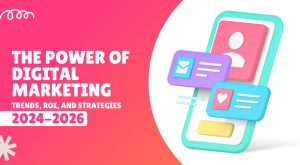In today’s hyper-connected world, digital marketing is no longer an option for businesses; rather, it is a necessity. With rapid advances in technology, the way brands engage with their audience has evolved significantly. As we dive into 2024, digital marketing is truly taking all these aspects to the next level, with businesses reaching gigantic audiences, having personalized communication, and optimizing their marketing strategies in real-time.
With more people spending time online-from social media to e-commerce platforms-digital marketing proves a more direct and measurable approach toward reaching consumers. Whether small business owner or an entrepreneur, in 2024, it continues to evolve at unprecedented speeds, and as businesses and consumers increasingly intertwine with technology, staying ahead of those very digital trends remains the key to success. It has changed the way brands interact with their customers, meaning, approaches that were effective sometime back are no longer effective today. Now personalization, automation, and high technology are still shaping it in ways that marketers need to establish their relevance and provide an opportunity.
This article explores the most recent trends and approaches in digital marketing for 2024: relating to a few of the most promising opportunities for businesses to expand their online presences and engagement with target audiences fruitfully.
1. The Age of Personalisation
Personalization is no longer just a buzzword in 2024, but a necessity for a brand to capture and retain the attention of customers. With consumers demanding more tailored experiences, companies can’t switch from generic content to highly targeted personalized interactions.
Data-driven insights: Given this large amount of consumers’ data, businesses can now easily understand their audiences’ preferences, buying behavior, and online activities. With the help of the data, a business can now craft personalized emails and website contents, recommend products and ads according to user behavior.
Hyper-targeted marketing: Demographics are a thing of the past. Marketers can’t apply mass-market gambits anymore but have to be led by micro-segmentation, where audiences are segmented on the basis of behavior, location, and interests and purchasing patterns.
AI-powered personalization: Artificial intelligence (AI) is the most effective machine that can automate and personalize because it goes through customer data to predict behavior in efforts to deliver targeted contents across multiple channels. AI improves user experiences through product personalization, chatbots, and dynamic websites.
Engaging customers based on their needs and requirements will only lead to a deeper engagement with their consumers, thus increasing their engagement and loyalty.
2. Emerging video content
Video will continue to be very prominent in digital marketing strategies for 2024. Shifting attention spans of consumers mean that video continues to remain the most convenient and efficient form of content through which brands can say what they need to say. Key Areas for Brands If a brand really wants to target the younger audiences, then these platforms are of foremost importance: TikTok, Instagram Reels, and YouTube.
Short-form video: On most social media, content that is under 60 seconds is most popular. Short, juicy movies look great while offering some glimpse behind the scenes or as user-generated content. Brands connect an extended audience using creative, snappy content that encourages likes, shares, and comments.
Live streaming. The live video is one of the biggest new trends: brands are using this tool for product launches, Q&As, and live shopping events. This creates real-time interactions that may have the effect of making audiences feel lively and engaged-and thereby enables them to join the conversation.
Storytelling through video: Storytelling is at the heart of video content in 2024, beyond promoting a product. Brands use video to tell authentic stories that resonate emotionally with their audience, building trust and community.
Video content still being the driving force behind such high engagement, its inclusion into wider digital marketing mix becomes even more pivotal for businesses looking to stay ahead of the curve.
3. Artificial Intelligence and Machine Learning
With AI and ML, digital marketing has now taken new ground. These help businesses optimize campaigns, analyze customer data, and make informed marketing decisions on several factors-all of which are major powers in automation and marketing enhancement.
Predictive analytics: AI-powered tools can sift through and analyze large volumes of data to predict the behaviors and trends of customers and their preferences as well. That means businesses can execute relevant marketing strategies based on their expected needs and stay one step ahead of the competition.
In customer support, such AI-powered chatbots are changing the customer experience through prompt response to queries raised by customers. Some of the basic queries may be responded to by such chatbots, they can assist in transactions, and also offer product suggestions through 24/7 customer services with very little human intervention.
Programmatic advertising: AI is further changing the way organizations approach digital advertising. It employs AI to automatically automate the buying of ads and the placing of ads in real time. This leads to very efficient advertising with low cost and good return on ad spend.
Businesses, therefore, introduce AI and ML into their strategy for digital marketing to streamline operations improve on efficiency, and make meaningful interactions with customers.
4. Voice Search and Smart Assistants
Voice search through the increasing use of smart speakers and virtual assistants, like Siri, Alexa, and Google Assistant, forms one of the crucial areas of SEO practice. By the year 2024, it has been estimated that almost half of the total searches will be carried out voice-based.
Optimizing for voice search: The business then needs to align its SEO strategy to rank well in voice searches. It happens because people use a more conversational and longer phrase in voice searches. Consequently, optimal content is created by optimizing for long-tail keywords and those directly answering questions.
Voice search local SEO is another area where a lot of voice search queries are looking for local services, like businesses, stores, or restaurants. Again, making sure you are taking advantage of local SEO by updating your Google My Business listings and making sure NAP – Name, Address, Phone – is consistent across all directories would be key to capturing this traffic.
Voice-activated content: Brands can create audio blog or voice-activated apps targeted towards voice assistants, making it much easier for the user to interact with them via smart speakers.
As voice search continues its rise, optimizing for it means that businesses will remain in tune and accessible to a much larger pool of users.
5. Social Commerce Influence
It really blurs lines between social media and e-commerce as we head into 2024, with people being able to shop directly from platforms of social media.
Regarding shopping, Instagram and TikTok have introduced their shopping feature where a user can buy from posts or videos. Brands can tag products and be responsible for initiating purchases from the post by indicating tags so that users can click on them to access the details of the product to make a purchase without leaving the app.
Live shopping events: Another social commerce trend is live streaming combined with ecommerce. Brands host live shopping events where influencers talk to people, show them products, answer questions, and give discounts in real time, so the viewers buy the product.
Shoppable posts and ads: social media has made it possible for businesses to connect their presence on the social media platform directly to sales. A click on a post or ad means users can buy the product with minimum trouble in the buying process.
Social commerce also allows businesses to connect directly with their consumers in places they spend time, thereby giving such frictionless shopping experience that is also going to increase in conversions.
6. The Shift to First Party Data
As the privacy concerns and data regulations stringently improve, so do marketers focus more on the collection of first-party data for the development of personalized marketing campaigns. This phase-out of third-party cookies has been the primary drive for businesses to focus on first-party data-that is all that information sourced directly from the customer.
Building trust through transparency: Concern for data privacy has grown extremely among consumers. Businesses can start building trust by being clear about how they collect, store, and use the data of customers. Trust developed through consent-based marketing and control over users’ data makes a stronger relationship.
Creating value through data: Data collection of first-party information such as email, browsing behavior, and purchase history creates much more relevant and personal marketing strategies for organizations. The notion would be to give something of value to value in exchange for customer data, be it a personalized offer, access to exclusive content, or a rewards program.
This approach will allow companies to take care of compliance with the privacy regulation, as well as offer highly personalized and effective marketing strategies.
7. Influencer Marketing Evolution
Influencer marketing is taking over the digital marketplace, but it’s not standing still. By 2024 authenticity will be the name of the game since the brand will look for a mixer or a match with influencers having the same values as them.
Micro and nano influencers: Instead of associating with influencers who have millions of followers, it has become a trend to associate with micro and nano influencers. They have a smaller focused audience rather than those millions of followers, thereby ensuring that the brand has a direct association with the consumer or target market. Their recommendation is also trusted more in this respect.
Long-term partnerships: Brands no longer do one-time campaigns with the influencer but are now creating long-term partnerships that make them more intimate with the brand and help create consistent messaging for the follower.
Influencer-led content creation: There is an increasingly new trend where brands engage the influencers more in the content creation process along with the brand, to create engaging authentic content speaking directly to its audience.
Authentic, values-based influencer marketing marks a wider practice in building trust and relationship with consumers.
Conclusion
Digital marketing in 2024 will continue to be dynamic, customer-centric, and technologically dependent. With greater adoption of trends like personalized content and video marketing, AI-driven automation, and voice search optimization, their approach will demand agility in cutting through the mess. In digital marketing, there’s always space for interaction, movement towards engagement, and sustained success for brands if done strategically.
This way, businesses stay ahead of these trends-the likes of social commerce, first-party data, and influencer marketing-and gain an edge in such a rapidly changing digital environment. Above all, they need to stay nimble, transform such data-driven insights into market decisions, and always prioritize the customer experience-a marketing professional’s first and only goal.
This article discusses the core digital marketing trends and strategies for 2024, giving a head start for companies to keep abreast of the digital wave and lead competition.
1. Rise of AI, Automation
Artificial intelligence and the automation of several processes through digital marketing have left businesses thinking about doing things differently. AI has been used so often to analyze consumer behavior, predict trends, and create personalized marketing campaigns. Automation also saves marketers time in all the ascribed processes by streamlining them progressively-from emails and then to social media control and content development.
AI Analytics: AI can process huge data sets and come up with the insights on what a customer likes, dislikes, or does. This will help marketers to target accurately and execute a campaign much more effectively.
Chatbots and virtual assistants: A chatbot that uses AI is highly in use today for customer service. Therefore, instant answers are provided through this AI-based chatbot, which increases user experience and engagement on websites and social media channels.
Automated campaigns: Marketing automation platforms like HubSpot and Marketo facilitate the sending of tailored emails and posting targeted content on social media. It tracks different interactions, all without requiring employees to constantly do so. It makes it more efficient and lets a company give the customer a unified experience.
AI and automation are helping brands interact with customers in a more efficient way, increasing conversion rates and ROI.
2. Content Marketing: Quality Over Quantity
Content marketing has remained one of the core pillars of digital marketing over 2024. However, the difference is in moving from a quantity to quality approach. In many cases, where there are plenty of pieces of content online, those businesses must then create high-value, relevant, and engaging content. It calls for really resonant messaging while at the same time solving their problems or answering questions that the audience may have.
Interactive Content: Interactive content, such as quizzes, polls, and interactive infographics, is engaging and may also allow users to experience more customized content. Such types of content engage the audience for a longer time on a website, thus increasing engagement and conversion.
Video Content: Video continues to remain a crucial part of digital marketing. From an economical TikTok clip to a lengthy YouTube content video, videos are effective at grabbing viewer attention and presenting messages in an entertaining way.
Podcasting and audio content: Podcasts and audio blogs have finally arrived and brands need to find newer means of reaching out to their audience. With the boom in voice search and smart speakers, audio content becomes an integral part of your digital marketing strategy.
Content marketing by 2024 is all about clearly understood needs of the target audience and the corresponding content, engaging yet informative .
3. The Role of Social Media Marketing
Social media remains at the heart of digital marketing, directly connecting businesses with their target market. However, in the ever-changing landscape, new platforms and trends emerge year after year. In 2024, social media marketing gets even more interactive and immersive.
Influencer marketing: Still pretty effective, though – it has evolved over time and now targets the micro and nano-influencers instead of the macro ones. The latter are those with a smaller number of subscribers, but they have closely attentive audiences, with which a brand can build an authentic relationship.
Social commerce: Here, Instagram and TikTok have simply linked shopping capabilities directly into the platform where one can acquire purchases, completely fusing the line between e-commerce and social media. This interface opens up new avenues of generating sales through social channels by transforming the way people shop online.
User-generated content (UGC): Prompt clients to share experiences of your brand on social media – it is a pretty effective way to build trust and engagement. Authenticity adds your brand – UGC provides social proof for your customers, which is likely to affect other customers to join in.
Social Media Marketing in 2024: Building true connections by engaging via the interactive content and forming a two-way conversation with customers.
4. SEO and the Voice Search Revolution
SEO is one of the most important parts of any 2024 digital marketing strategy, but it’s far from similar to what it was a few years back. One of the biggest shocks to SEO has been the rise of voice search and how virtual assistants like Siri, Alexa, and Google Assistant have become the favored options by people while seeking information online.
Voice search optimization: The marketer must optimise for conversational queries and long-tail keywords to rank well in voice search results. Voice searches are much more likely to be question-based and natural, so content has to be structured in a way that it answers that question head-on.
Mobile-first indexing: Google has adopted mobile-first indexing. Here, the mobile variant of your website is treated as the main variant as far as ranking is concerned. If you want to succeed with SEO, then your website should be mobile-friendly.
Featured Snippets: The top objectives of SEO are getting to the position zero in search engine results, which is ensured by featured snippets. This can be achieved by structuring your content so it answers common questions in a concise informative manner.
5. Move Towards User Privacy and Data Protection
6. Proven Earning Potential for Publishers
Now, data privacy is emerging as an issue for consumers, and companies have to change their digital marketing strategies about this. There is a rise in these kinds of regulations in Europe with GDPR and growing regulation and enforcement in California with CCPA in the U.S, therefore “transparency and data protection must now be given priority.”.
In its place, marketers are looking to first-party data—information that directly comes from the customers through their interactions on websites, email sign-ups, and social media. Since third-party cookies are being phased out, this information is far more reliable and aligns with the actual meaning of privacy regulations.
Consent-based marketing: Means that users would have clear consensus with before data collection or usage. Today, most regions demand explicit consent before collecting or using user data. The ability to establish and maintain trust based on transparent data usage will, therefore, become much more pivotal for brands in the future.
There will be a great need for privacy and data protection that would further call for more transparency over the collection and usage of customer data in ways that are still personalized in marketing.
6. Omnichannel marketing: Seamless customer experience Omnichannel marketing can now achieve the seamless integration of multiple channels, going as far as seamless elaboration of the customer experience on both online and offline canvases. By 2024, all customers will expect consistency and personalization of their relationship with a brand regardless of which they use to interact with that brand whether social media, email, or in-store.
Unified Messaging : The messaging on a brand should be consistent throughout the platforms. A customer should easily transition from your website to your social media page or physical store without any disconnect in brand experience.
Data Integration: The ability of delivering personalized experiences and engagement from marketers requires the use of integrated marketing tools that track customer behavior, enabling businesses to interact with customers based on their preference and behaviors.
With an omnichannel approach, companies can have even more structured connections with their audience and, thus, can develop stronger brand loyalty.
Conclusion
The digital space for 2024 suggests added complexity, essentiality, and dynamism from the previous years. With the increase in usage of AI, automation, and personalized content, the prospect of reaching the target audience for companies is much better and, therefore, has a much better chance of building marketing performance. Social media, SEO, and content marketing are at the core of any successful digital marketing approach which promises sustainable results, but now with an added force towards sustainability, privacy, and omnichannel experiences.
This is when incorporating new, innovative digital marketing practices will help businesses stay ahead of the trends and continue to thrive in this fast-paced and ever-evolving digital landscape. From mature marketers to the small business owner just looking to expand on its level of digital presence, embracing these strategies is all that ensures success into 2024 and beyond.





